Welcome to your comprehensive planting and gardening guide! If you’ve ever wanted to create a beautiful, thriving garden, you’ve come to the right place. In this guide, I’ll share with you everything you need to know to turn your green space into the oasis of your dreams.
Whether you’re a beginner or an experienced gardener, this guide is designed to provide you with the knowledge and tips you need to succeed. From getting started with gardening to planning your garden layout, choosing the right tools, and taking care of your plants, we’ve got you covered.
Key Takeaways:
- Consider your growing conditions and environment when choosing seed varieties.
- Plan your garden layout to ensure proper spacing and nutrition for your plants.
- Use a good growing medium and provide optimal conditions for seedlings.
- Explore different vegetable planting tips for beans, cucumbers, onions, peas, peppers, and tomatoes.
- Container gardening is a great option for smaller spaces, and companion planting can enhance productivity and deter pests.
In addition to the practical advice provided in this guide, we’ll also recommend additional resources such as books and online guides to further enhance your gardening knowledge. Remember, a beautiful and thriving garden is within your reach, and with the right guidance, your green space can become the envy of the neighborhood.
So, let’s get started on this exciting gardening journey together!
Beginner’s Gardening Tips: Getting Started
If you’re new to gardening, don’t worry – with a few simple tips and some patience, you’ll be well on your way to growing your own beautiful plants. Gardening can be a rewarding and enjoyable hobby that allows you to connect with nature and create a serene and vibrant outdoor space.
To start your garden, begin by selecting the right seeds or seedlings for your growing conditions. Consider the climate and environment in your area to ensure the best outcome. For vegetables, choose bush varieties for smaller gardens, and opt for fast-maturing varieties if you have a shorter growing season. When it comes to herbs, select based on size, growing habits, and life expectancy to find the perfect fit. Flowers can enhance the beauty of your garden and attract pollinators, with annuals offering easy removal and perennials returning every season.
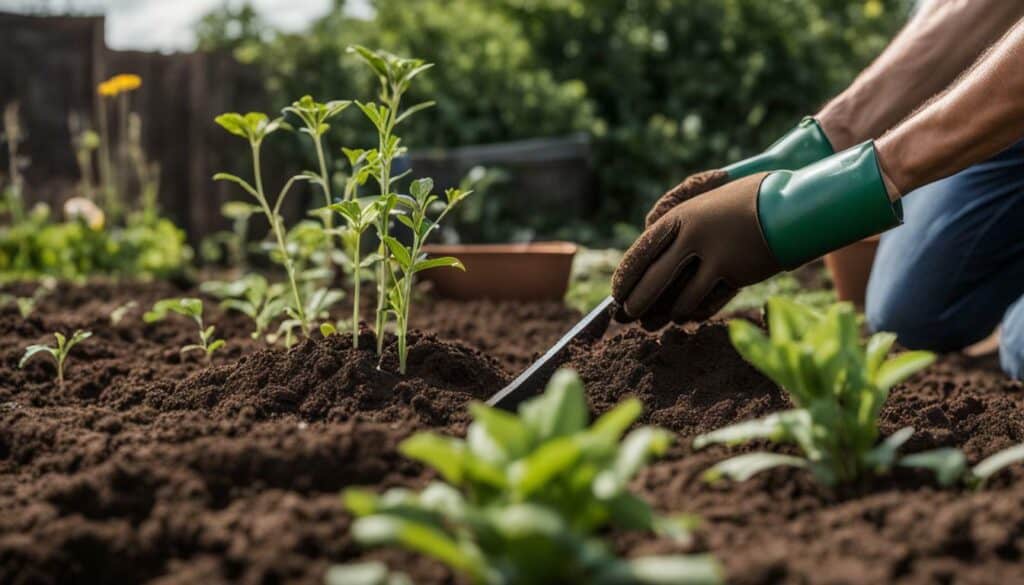
Proper planning is key to a successful garden. Determine the optimal location and spacing for your plants to ensure they have enough room to grow and receive adequate nutrition. Consider your family size and the purpose of your garden – whether you plan to freeze, can, or practice successive gardening for a continuous supply of fresh crops.
When it comes to sowing seeds, use a soil mix consisting of peat, perlite, and vermiculite. Most seeds require warmth, so aim for a soil temperature of around 70°F (21°C). Transplant seedlings to their final growing conditions in 4-inch pots once they have developed their first set of true leaves. Use a good growing medium, like a mixture of soil, peat moss, sand, and fertilizer. During the first week after transplanting, mist the seedlings frequently until they become established, then water thoroughly but less often. Some vegetables are suitable for direct sowing, while others thrive when started indoors.
Specific Vegetable Planting Tips
| Vegetable | Planting Tips |
|---|---|
| Beans | Direct sow into the garden, plant bush varieties every 12-18 inches (30-45 cm), and provide support for pole varieties. |
| Cucumbers | Require full sun, ample space, and a soil pH of 6.0-6.5. |
| Onions | Choose the right variety based on daylight requirements for your location. |
| Peas | Provide a bountiful harvest in limited space. Choose from garden peas, snap peas, snow peas, and cowpeas. |
| Peppers | Start seeds indoors as they can be difficult to germinate. |
| Tomatoes | Start indoors six weeks before the last frost date. They are the most popular vegetable in home gardens. |
If you have limited space, container gardening is a great option. Utilizing companion planting techniques can improve productivity, deter pests, suppress weeds, and attract beneficial insects and pollinators to your garden.
For additional guidance and information, consult books and online guides that specialize in beginner’s gardening tips. Your local Extension Service Agent can also provide personalized advice based on your specific location and needs.
Planning Your Garden: Location and Spacing
Before you start planting, it’s important to carefully plan the layout of your garden to ensure that your plants have the best chance of thriving. Proper planning will help you make the most of your space and maximize the potential of your garden. Here are some garden planning tips to get you started on the right track.
First, consider the location of your garden. Choose a spot that gets at least 6-8 hours of direct sunlight per day, as most vegetables and flowers require ample sunlight to grow and produce. Additionally, make sure the area has well-draining soil to prevent waterlogging, as excessive moisture can lead to root rot and other plant diseases.
Next, think about the spacing of your plants. Each plant has its own specific requirements for spacing, so it’s essential to give them enough room to grow. Overcrowding can lead to competition for resources and hinder the growth of your plants. Refer to seed packets or gardening books for recommended spacing guidelines for each type of plant you wish to grow.
Feeding your plants is also an important aspect of garden planning. Different plants have varying nutrient requirements, so it’s crucial to understand the needs of each plant to ensure proper nutrition. Consider using organic fertilizers or compost to provide essential nutrients to your plants throughout the growing season.
| Plant Type | Spacing | Feeding Options |
|---|---|---|
| Vegetables | Varies based on type | Organic fertilizers or compost |
| Herbs | Varies based on type | Organic fertilizers or compost |
| Flowers | Varies based on type | Organic fertilizers or compost |
Remember, planning is key to a successful garden. Take the time to research and consider the specific needs of your plants, and create a well-thought-out layout that takes into account proper spacing, sunlight, soil conditions, and feeding options. By doing so, you’ll be setting yourself up for a thriving garden that will bring you joy and beauty throughout the growing season.
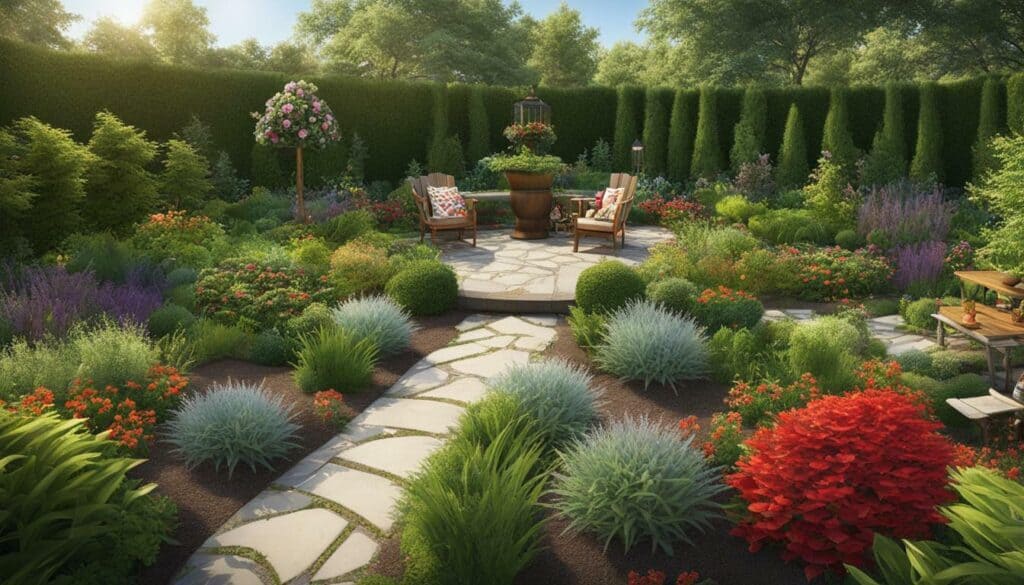
Essential Gardening Tools: What You Need
Just like any other task, having the right tools for the job can make all the difference when it comes to gardening. Whether you’re a beginner or an experienced gardener, having a well-equipped toolbox will ensure that you can tackle any gardening task with ease. Here are some essential gardening tools that every gardener should have:
| Tool | Description |
|---|---|
| Garden Gloves | Protect your hands from dirt, thorns, and sharp objects while providing a comfortable grip. |
| Hand Trowel | A versatile tool for digging, planting, and transplanting small plants or bulbs. |
| Pruning Shears | Used for trimming and shaping plants, removing deadwood, and harvesting fruits and vegetables. |
| Garden Fork | Great for loosening soil, aerating compost, and turning over garden beds. |
| Watering Can | An essential tool for watering plants, ensuring they receive the right amount of moisture. |
| Garden Hoe | Used for cultivating and weeding, breaking up the soil surface, and creating furrows for planting seeds. |
These are just a few examples of essential tools for your gardening arsenal. Depending on the size of your garden and the specific tasks you’ll be undertaking, you may also want to consider adding tools such as a rake, pruning saw, garden scissors, or a soil pH tester to your collection. Don’t forget to invest in a durable and well-made toolbox or garden tool organizer to keep your tools organized and easily accessible.
Quote:
“A garden without tools is like a canvas without a paintbrush – it’s the tools that bring your vision to life.” – Unknown
Remember, having the right tools not only makes gardening more efficient but also more enjoyable. So, invest in quality tools that suit your needs and take care of them properly. With the right tools in hand, you’ll be well-equipped to create and maintain a beautiful and thriving garden.

Plant Care Guide: Watering, Fertilizing, and Pruning
Taking care of your plants is essential to their overall health and productivity. Proper watering, fertilizing, and pruning practices will help your plants thrive and produce beautiful blooms or bountiful harvests. In this section, I’ll share some important tips to guide you in plant care.
Watering
Watering your plants correctly is crucial for their survival. It’s important to water deeply and infrequently rather than shallowly and frequently. This encourages strong root development as the roots will grow deeper in search of water.
Monitor the soil moisture level by sticking your finger about an inch into the soil. If it feels dry, it’s time to water. Use a watering can or a drip irrigation system to deliver water directly to the roots, avoiding wetting the foliage. Water in the early morning or evening to reduce evaporation and to give the plants ample time to absorb the moisture before the heat of the day.
Fertilizing
Feeding your plants with the right nutrients is essential for healthy growth. Choose a balanced fertilizer with equal amounts of nitrogen, phosphorus, and potassium (N-P-K) or a fertilizer specific to the type of plants you are growing. Follow the package instructions for application rates and frequency.
Apply fertilizer around the base of the plants, avoiding contact with the leaves. Water the soil after application to ensure the nutrients reach the root zone. Fertilize regularly during the growing season, but be careful not to overfeed as this can lead to nutrient burn and damage to the plant.
Pruning
Pruning helps shape your plants, promotes air circulation, and encourages new growth. Regularly remove dead or diseased leaves, flowers, or branches to prevent the spread of diseases and pests. Prune back overgrown or leggy plants to maintain their shape and improve their overall appearance.
When pruning, use clean and sharp pruning shears to make clean cuts just above a leaf node or bud. This will promote healthy new growth. Be mindful of the specific pruning requirements for different plants, as some may require specific techniques or timings.
“Taking care of your plants is like taking care of yourself. With proper hydration, nourishment, and regular maintenance, they will thrive and bring joy to your garden.”
Remember, each plant’s care requirements may vary, so it’s important to research and understand the specific needs of the plants you are growing. By providing adequate water, nutrients, and proper pruning, you’ll create a nurturing environment for your plants to flourish.
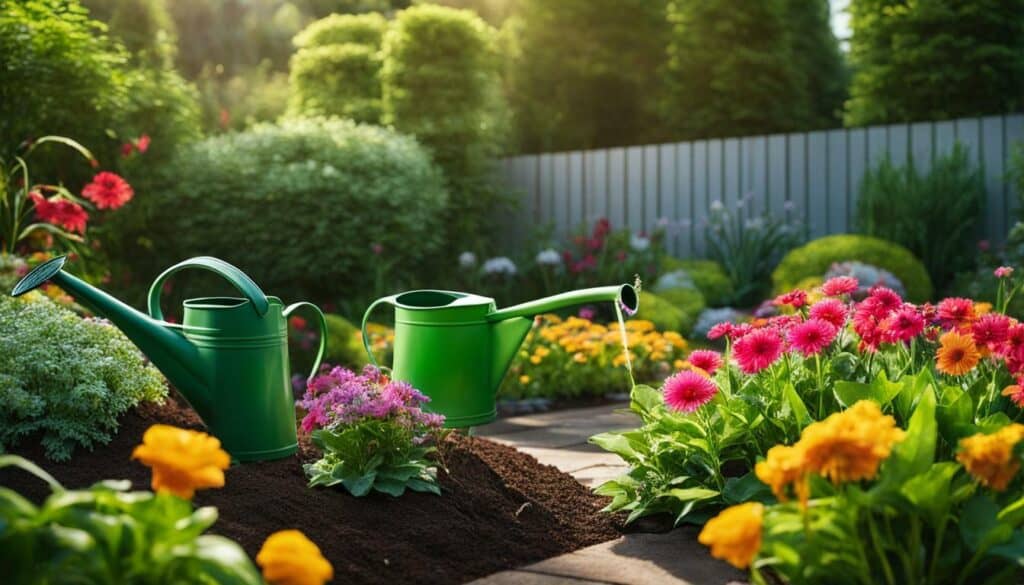
| Common Watering Mistakes | Proper Watering Techniques |
|---|---|
| Overwatering: This can lead to root rot and fungal diseases as excess water deprives the roots of oxygen. | Water deeply and less frequently, allowing the soil to dry out slightly between watering sessions. |
| Shallow watering: This encourages shallow root growth and makes the plants more susceptible to drought stress. | Water at the base of the plants, ensuring the water reaches the root zone. |
| Watering during the heat of the day: Most of the water evaporates before it can be absorbed by the plants. | Water in the early morning or evening to reduce evaporation losses and allow the plants to absorb the moisture effectively. |
| Watering from above: Wetting the foliage can promote the spread of diseases and encourage pests. | Water at the base of the plants to avoid wetting the leaves. |
Organic Gardening Techniques: Growing Naturally
If you prefer to grow your plants without the use of synthetic chemicals, organic gardening is a great option. Organic gardening focuses on nurturing the soil and using natural methods to promote plant health and ward off pests. In this section, I’ll share some essential organic gardening techniques to help you cultivate a thriving, chemical-free garden.
One of the key principles of organic gardening is building healthy soil. Start by enriching your soil with organic matter, such as compost or well-rotted manure. This will provide essential nutrients to your plants and improve soil structure. It’s also important to practice crop rotation, which helps prevent the buildup of pests and diseases in the soil. Rotate your crops each year, alternating plants from different families to maintain soil fertility.
In addition to building healthy soil, organic gardeners focus on natural pest control methods. Instead of relying on chemical pesticides, try using companion planting techniques. Certain plants have natural repellent properties that can deter pests from your garden. For example, planting marigolds near your vegetables can help ward off aphids and nematodes. You can also attract beneficial insects, such as ladybugs and lacewings, by growing flowers like daisies and alyssum. These insects feed on garden pests and help keep your plants healthy.
Another important aspect of organic gardening is proper watering and irrigation. Water your plants deeply and less frequently to encourage deep root growth and reduce water waste. Mulching around your plants can also help retain moisture in the soil and suppress weeds. Use organic mulch, such as straw or shredded leaves, to provide a protective layer that keeps the soil cool and moist.
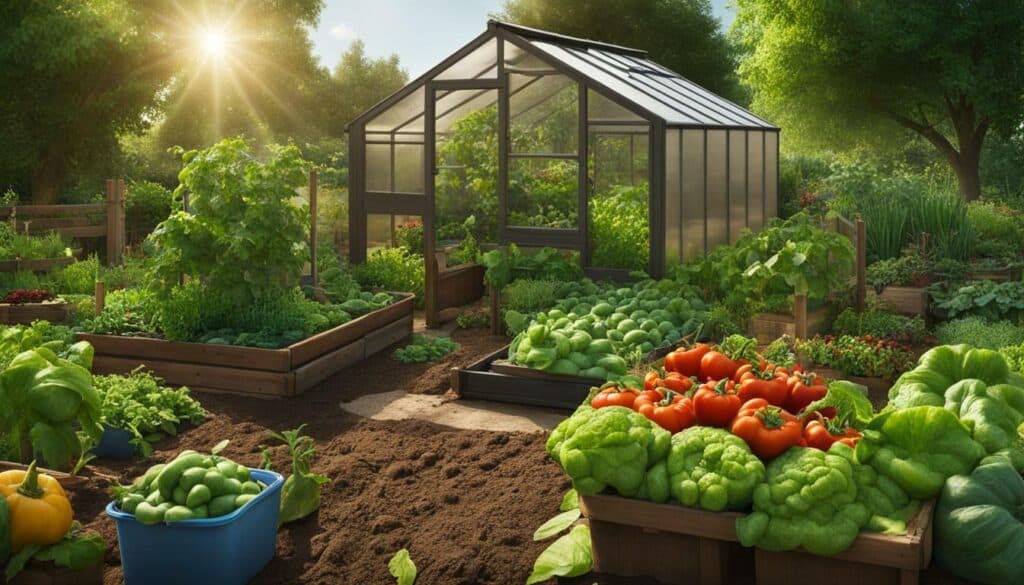
By incorporating these organic gardening techniques into your gardening routine, you can create a sustainable and eco-friendly garden that thrives naturally. By nurturing the soil, practicing natural pest control, and implementing proper watering techniques, you’ll be able to enjoy bountiful harvests while minimizing your impact on the environment. Remember, organic gardening is a journey of learning and experimentation, so don’t be afraid to try new methods and adapt them to suit your specific gardening needs.
Plant Propagation Methods: Growing from Seeds and Cuttings
Plant propagation is the process of creating new plants from existing ones, and it’s a valuable skill to have as a gardener. Whether you want to expand your garden or share your favorite plants with friends and family, learning how to propagate plants can be both rewarding and cost-effective.
When it comes to plant propagation, there are two main methods: growing from seeds and growing from cuttings. Each method has its advantages and is suitable for different types of plants.
Growing from Seeds
Starting plants from seeds is a common and economical way to propagate a wide variety of plants. It’s especially useful for annuals and vegetables that produce seeds, but can also be done with perennials and woody plants.
To get started, you’ll need a well-draining soil mix and containers, such as seed trays or pots. Plant the seeds at the recommended depth and keep the soil evenly moist until germination occurs. As the seedlings grow, make sure they receive adequate light and gradually acclimate them to outdoor conditions before transplanting them into the garden.
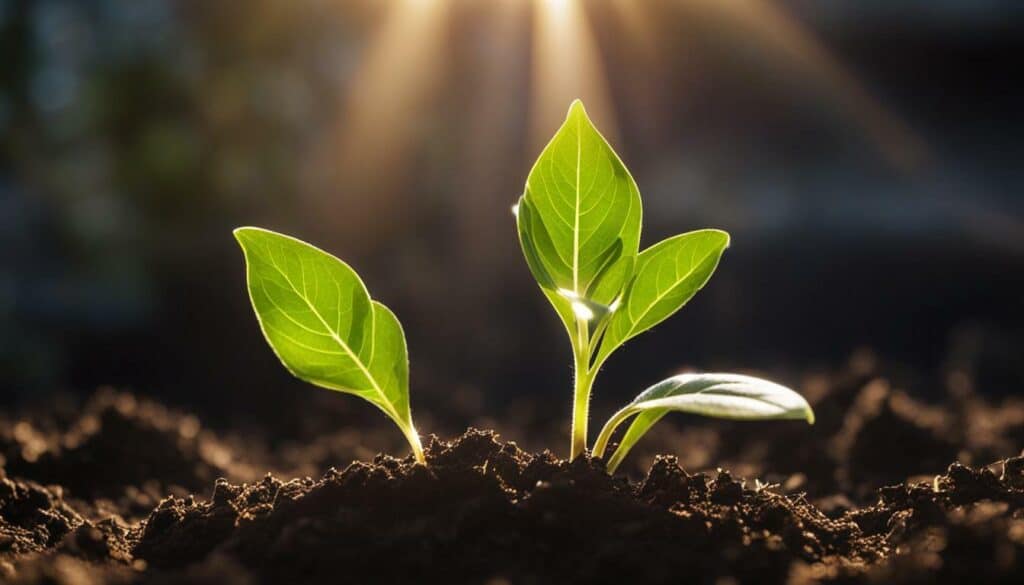
Some plants, like tomatoes, peppers, and cucumbers, are typically started indoors several weeks before the last frost date. Others, such as beans and peas, can be directly sown into the garden once the soil has warmed up. Be sure to follow the specific planting instructions for each type of plant to ensure the best results.
Growing from Cuttings
Another method of plant propagation is growing from cuttings. This involves taking a portion of a plant, such as a stem or leaf, and encouraging it to develop roots and grow into a new plant.
Cuttings can be taken from both herbaceous and woody plants, but certain plants, like roses, lavender, and mint, are particularly well-suited to this method. To propagate from cuttings, choose healthy, disease-free stems or leaves and make a clean cut just below a node. Remove any lower leaves that may be submerged in water or soil, and place the cuttings in a container filled with water or a well-draining rooting medium.
Keep the cuttings in a warm and humid environment, and mist them regularly to prevent them from drying out. After a few weeks, roots should start to develop, indicating that the cuttings have successfully propagated. At this point, they can be transplanted into individual pots or directly into the garden.
Whether you choose to grow from seeds or cuttings, plant propagation is a rewarding skill that allows you to expand your garden and share the beauty of plants with others. With the right techniques and a little patience, you can create an abundance of new plants that will bring joy and greenery to your space.
Seasonal Gardening Tips: What to Plant and When
To have a successful garden, it’s important to know which plants are best suited for each season. By understanding the optimal planting times and requirements for different crops, you can maximize your gardening efforts and enjoy bountiful harvests throughout the year.
Here are some seasonal gardening tips to guide you:
Spring:
- Start your spring garden by planting cool-season vegetables such as lettuce, spinach, kale, and broccoli. These crops thrive in the mild temperatures of early spring.
- Herbs like parsley, cilantro, and dill are also great additions to your spring garden.
- Consider planting annual flowers like pansies, petunias, and marigolds to add vibrant colors to your garden.
Summer:
- During the summer months, focus on warm-season vegetables like tomatoes, peppers, cucumbers, and squash. These crops require plenty of sunlight and warmth to grow.
- Herbs like basil, oregano, and rosemary thrive in the summer heat.
- Flowering plants like zinnias, sunflowers, and impatiens can add beauty to your summer garden.
Fall:
- As temperatures begin to cool, plant cool-season vegetables again, such as carrots, radishes, beets, and cabbage. These crops can tolerate light frost.
- Herbs like thyme, sage, and chives can continue to grow well into the fall.
- Fall is also a great time to plant bulbs like tulips, daffodils, and crocuses for a beautiful spring display.
Winter:
- In many regions, winter is a time of rest for the garden. However, you can still grow cold-hardy vegetables like kale, Swiss chard, and Brussels sprouts.
- Herbs like mint, lavender, and thyme can also withstand winter conditions.
- Consider planting evergreen shrubs and trees to provide structure and greenery to your winter garden.
Remember to adjust your planting dates and choices based on your specific climate and region. Your local Extension Service Agent can provide valuable insight and personalized advice for successful vegetable gardening in your area.
| Season | Best Vegetables | Best Herbs | Best Flowers |
|---|---|---|---|
| Spring | Lettuce, spinach, kale, broccoli | Parsley, cilantro, dill | Pansies, petunias, marigolds |
| Summer | Tomatoes, peppers, cucumbers, squash | Basil, oregano, rosemary | Zinnias, sunflowers, impatiens |
| Fall | Carrots, radishes, beets, cabbage | Thyme, sage, chives | Tulips, daffodils, crocuses |
| Winter | Kale, Swiss chard, Brussels sprouts | Mint, lavender, thyme | Evergreen shrubs, trees |
By following these seasonal gardening tips and selecting the right plants for each time of year, you can create a thriving and beautiful garden that brings you joy throughout the seasons.
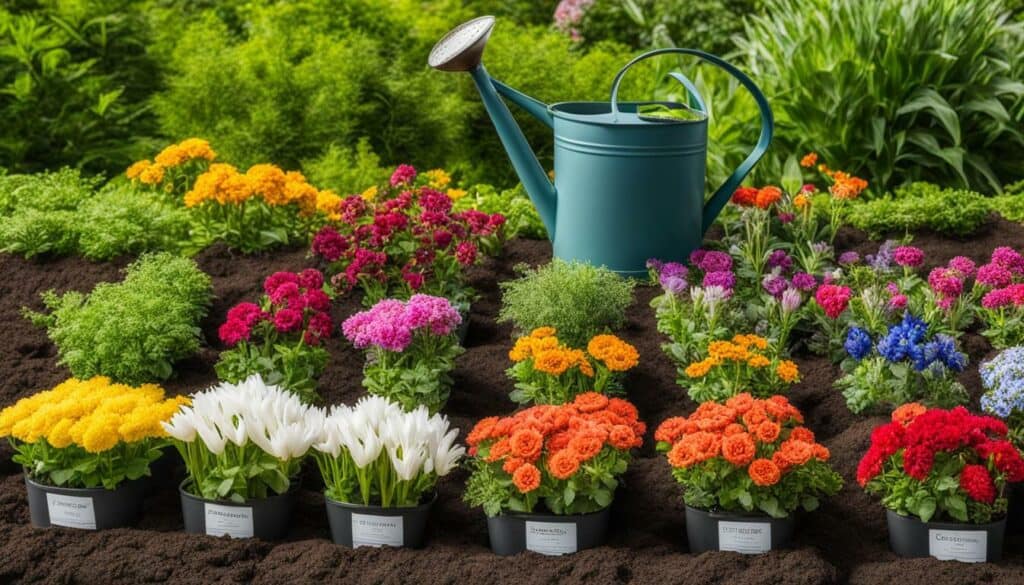
Container Gardening: Creating a Green Space in Small Areas
Don’t let limited space hold you back from gardening – container gardening allows you to create a beautiful garden in even the smallest of areas. Whether you have a window sill, balcony, or doorstep, containers provide the perfect solution for growing plants and adding a touch of greenery to your space. Not only are containers versatile and space-efficient, but they also offer a great opportunity for creativity and personalization.
When it comes to container gardening, the possibilities are endless. You can choose from a wide variety of containers, including pots, hanging baskets, and even repurposed items such as old buckets or wheelbarrows. Just make sure that your chosen container has drainage holes to prevent waterlogging and allow excess water to escape.

When selecting plants for container gardening, consider the specific requirements of each plant, such as sunlight, water, and soil preferences. Opt for compact varieties or dwarf cultivars that are well-suited to container growing. Mix and match different plants to create interesting combinations and textures.
Tips for Successful Container Gardening
- Choose a high-quality potting mix that is lightweight, well-draining, and rich in nutrients.
- Place your containers in an area that receives adequate sunlight for the types of plants you are growing.
- Water your containers regularly, checking the moisture level by sticking your finger about an inch into the soil. Water when the top inch feels dry.
- Fertilize your container plants with a balanced, water-soluble fertilizer according to the package instructions.
- Monitor your plants for pests and diseases and take appropriate measures to control them.
- Rotate your container plants periodically to ensure even growth and prevent plants from leaning towards the light source.
Container gardening not only allows you to bring nature into small spaces, but it also provides numerous benefits. You can easily move your containers to optimize sunlight exposure or protect plants from harsh weather conditions. Additionally, container gardening allows for better control over soil quality and drainage, reducing the risk of diseases and ensuring optimal plant growth. With a little planning and creativity, you can transform any small area into a lush and vibrant garden.
| Container Gardening Essentials | Additional Tips |
|---|---|
| Containers: Pots, hanging baskets, repurposed items | Consider using self-watering containers for added convenience |
| Potting Mix: Lightweight, well-draining, nutrient-rich | Add organic matter such as compost or aged manure to improve soil fertility |
| Plants: Compact varieties, dwarf cultivars | Combine plants with different growth habits for a visually appealing display |
| Sunlight: Adequate exposure for plant requirements | Use a sun-tracking app to determine the best location for your containers |
| Watering: Regular and consistent | Avoid overwatering by allowing the top inch of soil to dry out before watering again |
| Fertilizing: Balanced, water-soluble fertilizer | Follow recommended feeding intervals to promote healthy growth |
Companion Planting: Maximizing Garden Productivity
By strategically planting certain plants together, you can create a harmonious garden that benefits all of your plants. Companion planting is a technique that involves selecting plants that have mutually beneficial relationships, such as deterring pests, attracting pollinators, improving soil health, and maximizing space utilization. When done right, companion planting can significantly increase garden productivity and overall plant health.
To get started with companion planting, it’s important to understand which plants pair well together. Here are some popular companion plant combinations:
- Tomatoes and basil: Planting basil near tomatoes can repel pests like aphids and hornworms while enhancing the flavor of the tomatoes.
- Marigolds and vegetables: Marigolds emit a fragrance that repels many common garden pests, making them excellent companions for vegetables like tomatoes, beans, and cucumbers.
- Nasturtiums and squash: Nasturtiums act as a natural pest repellent, particularly against squash bugs and cucumber beetles, making them perfect companions for squash and other vine vegetables.
- Beans and corn: Growing pole beans up the stalks of corn can provide natural support for the beans while the beans fix nitrogen in the soil, benefiting both plants.
Companion planting can also be used to create a diverse garden that attracts beneficial insects and pollinators. For instance, planting flowers like lavender, sunflowers, and zinnias alongside your vegetables can attract bees and butterflies, enhancing pollination rates and overall garden health.
Table: Companion Planting Guide
| Plant | Companion Plant | Benefits |
|---|---|---|
| Tomatoes | Basil | Deters pests, enhances flavor |
| Marigolds | Vegetables | Repels pests |
| Nasturtiums | Squash | Repels pests |
| Beans | Corn | Nitrogen fixation |
Companion planting not only provides practical benefits but also adds beauty and diversity to your garden. The combinations are endless, so get creative and experiment with different plant pairings to see what works best for your specific garden.
Remember to consider the unique needs of each plant, such as sunlight, water, and soil requirements, when planning your companion planting arrangements. Additionally, be aware of plants that may have negative interactions, such as those competing for resources or emitting chemicals that inhibit growth in neighboring plants.
Companion planting is a sustainable and natural way to create a thriving garden ecosystem. By harnessing the power of plant partnerships, you can maximize garden productivity, deter pests, and create a visually stunning and diverse garden that will be the envy of your neighbors.
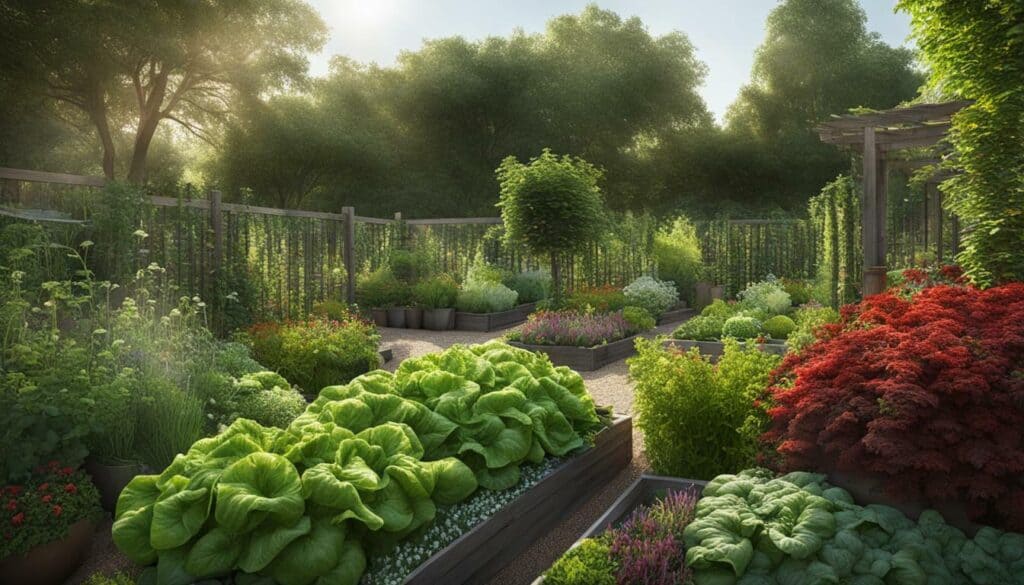
Additional Resources: Books and Online Guides
If you’re looking to expand your gardening knowledge, there are plenty of resources available to help you on your journey. Whether you prefer flipping through the pages of a book or browsing online guides, you’ll find a wealth of information to enhance your green thumb. Here are some recommendations for books and online guides to further inspire and educate you:
Books:
- The Vegetable Gardener’s Bible by Edward C. Smith: A comprehensive guide that covers everything from soil preparation to harvesting.
- Rodale’s Basic Organic Gardening by Deborah L. Martin: A beginner-friendly book that explores the principles of organic gardening.
- The Well-Tempered Garden by Christopher Lloyd: A classic gardening book filled with practical advice and captivating anecdotes.
Online Guides:
- The Old Farmer’s Almanac: A trusted resource with gardening tips, planting calendars, and weather forecasts.
- Gardeners.com: An online guide offering articles, videos, and expert advice on various gardening topics.
- Royal Horticultural Society: A British gardening organization with a wealth of information on plants, gardening techniques, and events.
Remember, these are just a few examples of the many resources available. Explore your local library or search online for more books and guides that cater to your specific gardening interests and needs. Happy reading and gardening!

Congratulations! You’ve reached the end of our comprehensive planting and gardening guide.
Throughout this guide, we’ve explored a wide range of topics to help you turn your green space into the oasis of your dreams. From beginner’s gardening tips to organic gardening techniques, we’ve covered everything you need to know to start and maintain a thriving garden.
When it comes to planting and gardening, choosing the right seeds and plants is crucial. Consider your growing conditions and environment to ensure the best outcome. Whether you’re growing vegetables, herbs, or flowers, selecting the right varieties can make all the difference.
Planning your garden is key to success. Determine the optimal location, spacing, and feeding options for your plants. Properly spacing your plants ensures they have enough room to grow and receive the necessary nutrients. And don’t forget to plan your yields based on your family size and preserving needs.
Whether you’re sowing seeds or transplanting seedlings, using the right soil mix and providing optimal growing conditions is essential. And for those with limited space, container gardening offers a fantastic solution. You can create a green space in small areas like window sills, balconies, and doorsteps.
By implementing companion planting techniques, you can maximize your garden’s productivity and create a harmonious environment for your plants. Companion plants can deter pests, suppress weeds, and attract beneficial insects and pollinators.
We hope this comprehensive planting and gardening guide has provided you with the knowledge and inspiration you need to create and maintain a flourishing garden. Remember, gardening is a journey, and it’s okay to make mistakes along the way. Enjoy the process, learn from your experiences, and watch your garden thrive.
For additional guidance and personalized advice, don’t hesitate to consult your local Extension Service Agent. They can provide valuable resources and support to help you achieve gardening success.
Thank you for joining us on this gardening journey. Happy planting!
What Are Some Essential Tips for Successful Planting in Little Gardens?
Discover the art of successful planting in little gardens and explore the joy of planting. To thrive in limited space, maximize vertical gardening with trellises and hanging baskets. Opt for compact varieties and utilize companion planting to make the most of your plot. Regular watering, proper soil preparation, and sufficient sunlight will ensure a flourishing garden oasis.
FAQ
Q: What factors should I consider when choosing seed varieties for my garden?
A: When choosing seed varieties, consider your growing conditions and environment to ensure the best outcome.
Q: What types of vegetables are suitable for smaller gardens?
A: For smaller gardens, select bush varieties of vegetables.
Q: What should I consider when choosing herbs for my garden?
A: When choosing herbs, consider their size, growing habits, and life expectancy.
Q: How can flowers enhance my garden?
A: Flowers can enhance your garden’s beauty and increase pollination rates.
Q: What should I consider when planning my garden layout?
A: When planning your garden layout, determine the location, spacing, and feeding options for your plants.
Q: How do I sow seeds for optimal growth?
A: When sowing seeds, use a soil mix consisting of peat, perlite, and vermiculite. Ensure a soil temperature of 70°F for most crops.
Q: When should I transplant seedlings?
A: Transplant seedlings to optimal growing conditions in 4-inch pots after they have developed their first set of true leaves.
Q: How often should I water seedlings after transplanting?
A: Mist seedlings frequently during the first week of transplanting until they are established, then water thoroughly but less often.
Q: Which vegetables are suitable for direct sowing?
A: Some vegetables are suitable for direct sowing, such as beans.
Q: How should I start pepper seeds?
A: Pepper seeds are difficult to germinate, so start them indoors.
Q: When should I start tomato seeds?
A: Tomatoes can be started indoors six weeks before the last frost date.
Q: What are the benefits of container gardening?
A: Container gardening is a great option for smaller spaces and offers flexibility in creating a green space.
Q: What is companion planting and how does it benefit my garden?
A: Companion planting involves planting specific plants together to maximize productivity and protect against pests.
Q: Where can I find additional resources for gardening advice?
A: For additional gardening advice and information, consider consulting books and online guides.

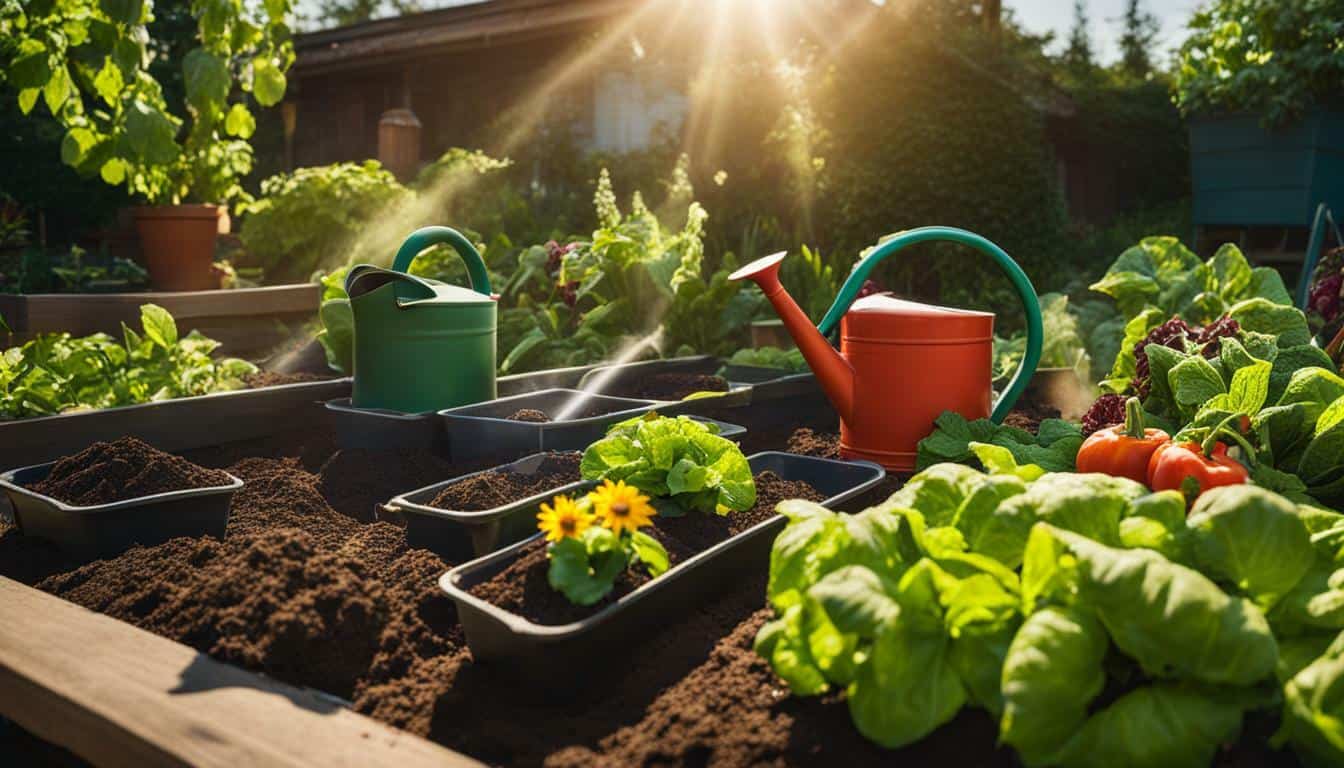



Leave a Reply